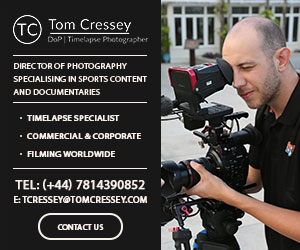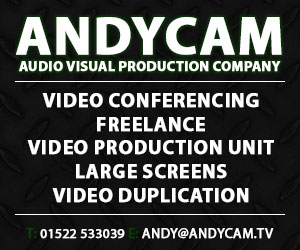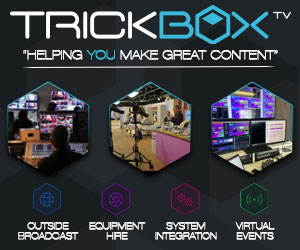Broadcast News
29/06/2012
Connected TV – What’s The Hold Up?

Screen’s connected TV specialist, Gordon Maynard explains how the market landscape drove the development of the company’s connected TV solution ScreenConnect.
You will have to go a long way to find someone in the media who doesn’t see the possibilities of connected TV. And yet for the vast majority of consumers it’s currently a mishmash of technologies, claims and general confusion. Despite this, users are seeking out connected TV services which offer clear benefits like the BBC iPlayer or LoveFilm.
So where’s the hold up? Why haven’t we seen a greater rush to the market, above and beyond noted trailblazers?
Well the plethora of connected TV platforms is not only a hindrance to the end user but is also presenting a considerable hurdle to market entrants.
Where’s the payback in Connected TV?
Viewing habits are changing, driven both by video on the internet and PVR technology and we are moving into a developing “pull” universe.
While the market is currently fractured, connected TV offers a potent route to market with a significant audience and technology that circumvents the existing pay platforms.
Group together all the homes with connected TV capability and you have a vast platform: you just have to overcome the technical and commercial obstacles to addressing that audience in one go. The fact is that if broadcasters do not move into this space then it will become dominated by internet brands and the real estate that connected TV offers is simply too valuable to miss.
If service providers want people to watch their catch-up TV service then they have to put that service where people want it, leading ultimately to the EPG on the TV. If their business is getting people to watch catch-up TV then the advantages are that they can supply iPlayer-type services to the best screens to view it on, that’s to say, not the PC. We are talking about moving connected TV to a mass market proposition.
In the VOD market it’s about selling people content in the place that they want it. Selling movies? Well then let’s all have a movie experience watching it.
Content owners can provide people with a high value, lean-back, second screen experience for their information services. A well packaged information experience around non-linear content is very important to drive usage and over time connected TV will gain services a larger audience; one that’s more engaged.
With shopping it’s about expanding the opportunity to sell, introducing greater access to the shopping experience. Users can access product information and the associated ‘buy’ action even though they’ve missed the linear broadcast.
For many special interest ‘channels’ connected TV is the only viable business model going forwards to access TV screens.
The problem with connected TV
So what is preventing so many broadcasters and brands from entering the market? Firstly, there’s consumer knowledge: many of those who buy TVs with the ability to connect still aren’t necessarily connecting them as yet.
As awareness of connected TV and its benefits grows, more users will connect up their receivers and the arrival of WiFi-enabled TVs, Blu-Ray players and games consoles also make that much easier.
The second is that there are a very large number of technologically different connected TV platforms, so that service providers have to make a separate application for each and every service. It is not cheap, it is not quick to do and it’s holding the market back.
With so many services still not appearing, where’s the consumer driver to adopt connected TV?
What’s required to move forwards?
Ideally a service provider requires access to the maximum number of platforms without having to devote the very significant time and cost to writing applications for each and every one.
More advanced platforms will be developed that will need to be supported so those who plan their infrastructure to be flexible will succeed.
As platform specs are constantly changing, however subtly, connected TV apps can become out of date swiftly, meaning that updates will need to be written and applied, again for multiple platforms.
As well as the apps themselves, overall management is required so that applications can be accessed for all platforms rather than having an individual control tool for each one. If every application has a separate control tool for simple manipulation then the user is faced with a confusion of interfaces and protocols.
The third key issue is that platforms need to approve the applications prior to hosting them, therefore the applications must adhere tightly to each platform’s requirements, requirements that evolve and shift.
In the majority of cases, connected TV services are not going to be run in isolation, rather they will in some way be linked to either an existing website, broadcast channel(s) or transaction service. The ability to handle external feeds and indices and to dovetail with already deployed transaction/asset management systems without distribution is also vital.
Removing market entry hurdles
Service providers are facing very considerable hurdles to market entry; even now platforms are coming and going. It is impossible for service providers to back clear winners; adaptability and choosing the right partners is key.
Connected TV is here and here to stay. Broadcasters and service providers of all shapes and sizes need to consider the opportunities and be assured that the market entry issues are now being addressed by new technology.
You will have to go a long way to find someone in the media who doesn’t see the possibilities of connected TV. And yet for the vast majority of consumers it’s currently a mishmash of technologies, claims and general confusion. Despite this, users are seeking out connected TV services which offer clear benefits like the BBC iPlayer or LoveFilm.
So where’s the hold up? Why haven’t we seen a greater rush to the market, above and beyond noted trailblazers?
Well the plethora of connected TV platforms is not only a hindrance to the end user but is also presenting a considerable hurdle to market entrants.
Where’s the payback in Connected TV?
Viewing habits are changing, driven both by video on the internet and PVR technology and we are moving into a developing “pull” universe.
While the market is currently fractured, connected TV offers a potent route to market with a significant audience and technology that circumvents the existing pay platforms.
Group together all the homes with connected TV capability and you have a vast platform: you just have to overcome the technical and commercial obstacles to addressing that audience in one go. The fact is that if broadcasters do not move into this space then it will become dominated by internet brands and the real estate that connected TV offers is simply too valuable to miss.
If service providers want people to watch their catch-up TV service then they have to put that service where people want it, leading ultimately to the EPG on the TV. If their business is getting people to watch catch-up TV then the advantages are that they can supply iPlayer-type services to the best screens to view it on, that’s to say, not the PC. We are talking about moving connected TV to a mass market proposition.
In the VOD market it’s about selling people content in the place that they want it. Selling movies? Well then let’s all have a movie experience watching it.
Content owners can provide people with a high value, lean-back, second screen experience for their information services. A well packaged information experience around non-linear content is very important to drive usage and over time connected TV will gain services a larger audience; one that’s more engaged.
With shopping it’s about expanding the opportunity to sell, introducing greater access to the shopping experience. Users can access product information and the associated ‘buy’ action even though they’ve missed the linear broadcast.
For many special interest ‘channels’ connected TV is the only viable business model going forwards to access TV screens.
The problem with connected TV
So what is preventing so many broadcasters and brands from entering the market? Firstly, there’s consumer knowledge: many of those who buy TVs with the ability to connect still aren’t necessarily connecting them as yet.
As awareness of connected TV and its benefits grows, more users will connect up their receivers and the arrival of WiFi-enabled TVs, Blu-Ray players and games consoles also make that much easier.
The second is that there are a very large number of technologically different connected TV platforms, so that service providers have to make a separate application for each and every service. It is not cheap, it is not quick to do and it’s holding the market back.
With so many services still not appearing, where’s the consumer driver to adopt connected TV?
What’s required to move forwards?
Ideally a service provider requires access to the maximum number of platforms without having to devote the very significant time and cost to writing applications for each and every one.
More advanced platforms will be developed that will need to be supported so those who plan their infrastructure to be flexible will succeed.
As platform specs are constantly changing, however subtly, connected TV apps can become out of date swiftly, meaning that updates will need to be written and applied, again for multiple platforms.
As well as the apps themselves, overall management is required so that applications can be accessed for all platforms rather than having an individual control tool for each one. If every application has a separate control tool for simple manipulation then the user is faced with a confusion of interfaces and protocols.
The third key issue is that platforms need to approve the applications prior to hosting them, therefore the applications must adhere tightly to each platform’s requirements, requirements that evolve and shift.
In the majority of cases, connected TV services are not going to be run in isolation, rather they will in some way be linked to either an existing website, broadcast channel(s) or transaction service. The ability to handle external feeds and indices and to dovetail with already deployed transaction/asset management systems without distribution is also vital.
Removing market entry hurdles
Service providers are facing very considerable hurdles to market entry; even now platforms are coming and going. It is impossible for service providers to back clear winners; adaptability and choosing the right partners is key.
Connected TV is here and here to stay. Broadcasters and service providers of all shapes and sizes need to consider the opportunities and be assured that the market entry issues are now being addressed by new technology.
Top Related Stories
Click here for the latest broadcast news stories.
15/06/2023
Imagine Communications Publishes 'Connected TV Ad Buying: A Survey of Ad Agency Buyers'
Imagine Communications has published 'Connected TV Ad Buying: A Survey of Ad Agency Buyers', a comprehensive report presenting media companies with va
Imagine Communications Publishes 'Connected TV Ad Buying: A Survey of Ad Agency Buyers'
Imagine Communications has published 'Connected TV Ad Buying: A Survey of Ad Agency Buyers', a comprehensive report presenting media companies with va
27/09/2012
smartclip Publish Findings On Connected TV Users
smartclip, the multiscreen video and brand advertising platform, has published the findings of the first ever research on Connected TV users. In assoc
smartclip Publish Findings On Connected TV Users
smartclip, the multiscreen video and brand advertising platform, has published the findings of the first ever research on Connected TV users. In assoc
30/01/2012
Screen’s New Connected TV Solution At BVE
Screen will be exhibiting ScreenConnect, its new connected TV publishing tool at this year’s BVE in London. The show will also be Screen’s first indus
Screen’s New Connected TV Solution At BVE
Screen will be exhibiting ScreenConnect, its new connected TV publishing tool at this year’s BVE in London. The show will also be Screen’s first indus
08/12/2011
Verizon To Compete In Connected TV Industry
A tele-communications firm plan to launch a standalone service allowing customers to stream movies and television shows over the Web – entering them i
Verizon To Compete In Connected TV Industry
A tele-communications firm plan to launch a standalone service allowing customers to stream movies and television shows over the Web – entering them i
07/12/2011
Connected TV Industry Forum Speakers Revealed
The keynote speakers for a forum, which will provide insight into the IP and connected TV industry, have been announced. IP&TV World Forum, a connecte
Connected TV Industry Forum Speakers Revealed
The keynote speakers for a forum, which will provide insight into the IP and connected TV industry, have been announced. IP&TV World Forum, a connecte
08/04/2011
S&T Delivers OTT Content To Connected TV
Strategy & Technology (S&T) is helping to deliver on demand video content over broadband to set-top boxes and integrated digital televisions (iDTVs).
S&T Delivers OTT Content To Connected TV
Strategy & Technology (S&T) is helping to deliver on demand video content over broadband to set-top boxes and integrated digital televisions (iDTVs).
20/03/2025
Nessma TV Launches Special Ramadan TV Show
NINETNINE has announced that leading entertainment TV channel Nessma TV, has launched a special Ramadan TV show 'Koujinetna Haka by Samia' designed fo
Nessma TV Launches Special Ramadan TV Show
NINETNINE has announced that leading entertainment TV channel Nessma TV, has launched a special Ramadan TV show 'Koujinetna Haka by Samia' designed fo
14/03/2025
Unicanal And Trece TV Revolutionise Digital TV In Paraguay
Successful deployment of the R&S®THU9evo and R&S®TMU9evo transmitters in key cities marks a significant milestone in Paraguay's digital transition. Un
Unicanal And Trece TV Revolutionise Digital TV In Paraguay
Successful deployment of the R&S®THU9evo and R&S®TMU9evo transmitters in key cities marks a significant milestone in Paraguay's digital transition. Un
20/02/2025
Agile TV, United Teleports And BNS Launch A More Profitable TV Service
AgileTV, United Teleports and BNS have announced a game-changing new fully managed TV service that addresses the limitations of today's existing video
Agile TV, United Teleports And BNS Launch A More Profitable TV Service
AgileTV, United Teleports and BNS have announced a game-changing new fully managed TV service that addresses the limitations of today's existing video
09/04/2024
HKT's Now TV Deploys VO's AI-Driven Targeted TV Advertising Solution
Viaccess-Orca (VO) has announced that HKT's Now TV is using VO's AI-driven Targeted TV Advertising solution to deliver addressable TV to viewers. By o
HKT's Now TV Deploys VO's AI-Driven Targeted TV Advertising Solution
Viaccess-Orca (VO) has announced that HKT's Now TV is using VO's AI-driven Targeted TV Advertising solution to deliver addressable TV to viewers. By o
10/06/2022
PA TV Metadata Partners With Together TV
PA TV Metadata has teamed up with Together TV to power its free-to-use streaming platform as the TV channel looks to engage with new audiences. PA TV
PA TV Metadata Partners With Together TV
PA TV Metadata has teamed up with Together TV to power its free-to-use streaming platform as the TV channel looks to engage with new audiences. PA TV
04/10/2021
nangu.TV Reveals New Android TV Operator Set-Top Box
nangu.TV has unveiled a new Android TV Operator Tier set-top box, run on the nangu.TV platform, in cooperation with Orange Slovensko and CommScope. Re
nangu.TV Reveals New Android TV Operator Set-Top Box
nangu.TV has unveiled a new Android TV Operator Tier set-top box, run on the nangu.TV platform, in cooperation with Orange Slovensko and CommScope. Re
25/02/2019
TV Nitrička And TV Zobor Acquire EXEcutor HD Combo Server
TV Nitrička with TV Zobor have acquired from PBT EU an EXEcutor HD Combo server. The solution is comprised of the PlayBox AirBox Neo for playback
TV Nitrička And TV Zobor Acquire EXEcutor HD Combo Server
TV Nitrička with TV Zobor have acquired from PBT EU an EXEcutor HD Combo server. The solution is comprised of the PlayBox AirBox Neo for playback
12/12/2018
Guigo TV Launches OTT Offering Powered By VO's TVaaS Cloud-Based TV Platform
Viaccess-Orca (VO) has announced that Brazil's Guigo TV is launching a new OTT offering powered by VO's TVaaS cloud-based TV platform, VO's DRM soluti
Guigo TV Launches OTT Offering Powered By VO's TVaaS Cloud-Based TV Platform
Viaccess-Orca (VO) has announced that Brazil's Guigo TV is launching a new OTT offering powered by VO's TVaaS cloud-based TV platform, VO's DRM soluti
06/12/2018
Insight TV - The Most Adventurous TV Channel In The World
Insight TV has significantly grown over the last three years and has recently partnered with TCL to create a Smart TV app. BFV talks to CEO Rian Beste
Insight TV - The Most Adventurous TV Channel In The World
Insight TV has significantly grown over the last three years and has recently partnered with TCL to create a Smart TV app. BFV talks to CEO Rian Beste















